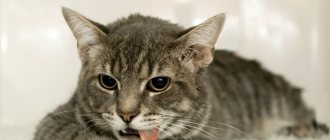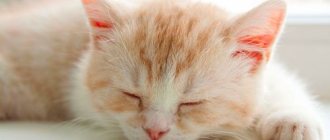Vomiting in cats is a condition that is familiar to many owners of these animals. And the reasons for this phenomenon can be different - from harmless to severe, life-threatening for the pet.
Murka ate too much, and here you go - she vomited everything up. Or she licked her luxurious fur, and then vomited balls of fur. These are physiological manifestations. But there are cases when this symptom indicates serious illness. And especially cat owners should be wary if there is blood. Bloody discharge in cats is one of the most dangerous of all types.
Pay attention to the appearance of the vomit.
Vomiting in a domestic cat: causes
These animals have a rough tongue that acts as a brush. Thus, they get rid of debris, dust and remnants of hair that has fallen out. Accordingly, they swallow part of the wool. To get rid of the extra hairball, cats burp. However, in this case, before burping, the animal moves its tongue, releasing a huge amount of saliva and mucus so that the hairball can more easily pass through the esophagus to the outside. The animal does not experience any pain or blood during the process of vomiting hair.
Vomiting in a domestic cat, causes:
- If there is no blood in the vomit, the cause can be determined by its color and nature. It is not uncommon for kittens one to two months old to vomit white foam. This happens if they are given complementary foods in the form of solid foods. This is an addiction that does not pose a threat to babies. In an adult cat, white foamy vomit indicates overeating, or that the food she is being fed is not suitable. Therefore, it makes sense to change the animal’s diet.
- It is worth noting that an adult cat does not have microflora in the intestines that help break down milk. Therefore, it is not advisable to give dairy products to adult cats. They can cause vomiting white foam.
Group of factors
If a cat is vomiting blood, there may be different reasons. Among them:
- injury to the walls of the stomach - ulcer;
- pathological gastritis;
- leptospirosis – cats get sick at a young age (under 12 months);
- piroplasmosis;
- the presence of heartworms (simple types of parasites);
- entry into the body of an animal of a foreign body;
- renal failure;
- parvovirus enteritis as a consequence of complications;
- injury in the abdominal area;
- taking the wrong dosage of non-steroidal anti-inflammatory drugs;
- The cat is vomiting blood from the grass.
What does the color of a cat's vomit mean?
If your pet vomits clear liquid or mucus without visible food particles, this may indicate pancreatitis, cholecystitis, gastritis, and helminthic infestation. Be sure to give your pets anthelmintic medications once every 3 months. Despite the fact that indoor cats do not go anywhere, they need anthelmintics. This is necessary if the animal is given food from the table rather than fed dry food.
What does the color of a cat's vomit mean?
- By the color of your pet's vomit, you can determine which part of the body is affected. If the vomit is bright yellow in color, with a characteristic bitter odor, this indicates that there is a large amount of bile in the vomit. In most cases, this indicates problems with the bile ducts, liver and severe stress on the digestive organs and pancreas. Perhaps the pet is not fed correctly, is given too fatty foods or food that is not allowed to eat. This often happens after changing food. Carefully look at the composition of the new product.
- If the vomit is green, in most cases this does not mean anything bad. Animals that walk outside consume grass to cleanse their bodies. It is this that can turn vomit green. With its help, they cleanse the intestinal walls and improve the condition of the body.
- White vomiting, which occurs once a day, indicates that the animal is getting used to a new diet. This often happens in kittens.
The cat is unwell
Medical nutrition
During therapy, in addition to the use of medications, it is important to put your pet on a therapeutic diet. Do not forget about drinking; to prevent dehydration, it is useful to add a solution of electrolytes to the liquid. The cat may refuse to drink such liquid. If you can’t get something to drink, the animal breaks out and IVs are placed in the hospital. Meals during treatment should consist only of natural products. The menu includes meat baby food, rice, boiled potatoes, chicken, low-fat cottage cheese and kefir. The number of meals is 4-6 times a day. If your cat doesn't eat enough, you need to remove the food. They switch to the usual diet gradually, gradually adding other foods.
Vomiting blood in a cat: causes
However, there are also pathological processes that have characteristic symptoms. It is not uncommon for pets to vomit blood. By its color and character, you can determine which of the body systems is malfunctioning.
Vomiting blood in a cat, causes:
- If the vomit contains small streaks of scarlet or orange blood, the problem is in the esophagus, larynx, or oral cavity. When such a symptom appears, examine the animal’s mouth and larynx.
- Cats can ingest or smell harsh chemicals found in toilet and sink cleaners. As a result of ingestion of products containing alkalis and acids, the surface of the larynx and oral cavity may bleed and become bright red.
- The appearance of a small amount of blood in the vomit may be due to dental diseases that occur in mature animals. If there is a large amount of bright red, scarlet blood in the vomit, there is definitely a problem in the esophagus and throat.
- Perhaps the animal took food with spicy inclusions. This happens when animals are given fish or chicken bones. When crushing bones with teeth, sharp fragments can damage the surface of the mucous membrane of the esophagus, even to the point of perforation. This is why cats are not fed fish and chicken bones.
Medicines, vitamins and minerals
Considering that many useful substances come out of the cat’s body with vomit, the owner of the animal needs to take measures to restore the vitamin and mineral components in the pet’s body. Nutrient complexes are sold in pet stores.
When a cat burps blood, he can lose a lot of energy. To restore strength and replenish the body with blood, doctors prescribe products containing iron (for example, Tardiferon or Totema). Pets love to consume them in the form of a suspension and drops.
Why does my cat vomit black?
The situation must be treated differently if the vomit contains blood that is not bright red, but dark burgundy, brown or black.
Why does my cat vomit black?
- This means that the blood enters into a chemical reaction with the gastric juice, which contains acid.
- It was thanks to the effect of acid on hemoglobin that the blood changed its color. This means that the problem is in the gastrointestinal tract.
- The animal may have malignant neoplasms, ulcers or gastritis from improper feeding or chemical poisoning.
- Such disorders are observed in diseases of the small intestine.
If the problem is in the large intestine, then the animal does not vomit blood, because it comes out through the anus, along with the feces. With pathologies of the large intestine, blood can be observed in the animal's excrement.
The cat is sick
Literature:
- Grinenko A. Ya. Chronic alcohol intoxication. - St. Petersburg: Legal Center Press, 2007. - 537 p.
- Drozdov E. S., Zenchenko E. I. Alcoholism: 100 questions and answers. - M.: Soviet Russia, 1988. - 133 p.
- Melnikov A.V. Alcoholism. A recovery guide for drinkers and their loved ones. - M.: Practical Medicine, 2022. - 256 p.
- Luzhnikov E. A., Sukhodolova G. N. Acute poisoning in adults and children. - M.: Eksmo, 2009. - 560 p.
Need some advice?
OR CALL A DOCTOR
CALL!
+7
Cat vomits undigested food
To understand the cause of vomiting, you need to consult a veterinarian. Most often, an ultrasound of the digestive organs, as well as various tests, may be needed to determine the cause. The doctor will carefully examine the animal, asking the owner for symptoms. Pieces of food or food may be found in your cat's vomit. If this did not happen, and the day before a new food was introduced, it may not be suitable for your pet.
Causes of a cat vomiting undigested food:
- Large amount of food. Very often, pet owners do not control the amount of food, pouring food to the top of the bowl. Thus, the animal eats everything in the container, and then comes for more. Despite the fact that cats, unlike dogs, do not tend to overeat, some pets, especially those who previously lived on the street, remember times of hunger. These are the animals that eat much more than they need. After absorption of food, it increases in size in the stomach and has an irritating effect on the walls. This results in vomiting. Thus, the animals get rid of excess food.
- Overeating happens in competitive conditions; if there are several animals at home at once, they are afraid of not keeping up with the others. Therefore, try to feed the animals separately, bringing each pet into the room, closing the door behind you. Thus, the rest will not snatch food from the animal, and it will not try to eat more food. Automatic feeders that dispense a certain portion of food have proven themselves very well. The likelihood of overeating is minimized.
Pay attention to the composition of the new food. Many owners purchase dry food because of its low price, because it does not require the introduction of additional food products. However, all food that is sold in stores is economy-class products containing a large amount of carbohydrates and a minimal amount of proteins. If the owner decides to change the food to a higher quality one, high in protein and meat, the animal will have an adaptation period. Within a week, the pet will get used to the new food, and vomiting with pieces of food is possible.
Bad feeling
How to treat vomiting in a domestic cat?
Vomiting may be a sign of a serious infection. That is why animals, regardless of age, need to be vaccinated to prevent the development of feline diseases. If, despite the actions taken, the reduction in the amount of food, the cat continues to vomit, it must be shown to a veterinarian.
How to treat vomiting in a domestic cat:
- To conduct research, animal owners are asked to take an x-ray. Indeed, often the cause of vomiting is the entry of foreign objects into the digestive organs. This could be a children's construction set or parts from small toys that the animal can swallow along with food. Foreign objects irritate the walls of the stomach, causing severe cramps and vomiting. This is a way to get rid of a foreign object that is inside the abdominal cavity.
- Please note that in case of helminthic infestation, in no case should you give a large amount of antiparasitic drugs. This applies to animals that have lived on the street for a long period of time and are underweight, but at the same time they have a bloated stomach.
- When an anthelmintic drug acts, a large number of toxic components are formed in the body as a result of the breakdown of worms. It is these toxic substances that can kill an animal, especially if it is a kitten. Therefore, give such remedies in doses, in small portions. It is better to consult a veterinarian to ensure that you follow the required dosage and in no case exceed the permissible limit.
Importance of treatment
It is forbidden to ignore such symptoms in an animal. Most often, vomiting with blood indicates that the cat has a chronic ulcer, which occurs due to poor nutrition. In this case, the wounds open from time to time and release blood, which provokes vomiting and scarring. When bleeding begins, the animal begins to feel unwell and loses its appetite completely or partially.
Each disease requires complex treatment, which can only be prescribed by a veterinarian after diagnostic measures. It is for this reason that if there is vomiting with blood, regardless of its frequency and intensity, it is important to visit the clinic without fail; treating your pet yourself is prohibited, as this can lead to dangerous consequences and endanger the life and condition of the animal’s body. Also, the cat's owner loses valuable time.
What to give a cat for vomiting?
Veterinarians do not recommend giving pets antiemetic drugs, because vomiting is a protective reaction of the body. The body is trying to get rid of a foreign object, excess food. In addition, the risk of making a mistake with the dosage is very high. In no case should you self-medicate, because very often the cause of vomiting can be not only infections, but also foreign objects, wool, which enters the intestines.
What to give your cat for vomiting:
- In this case, it is useless to give the animal antibiotics. To remove hair from the stomach, the cat is given special pastes. They help quickly remove foreign objects from the gastrointestinal tract. Pay attention so that the cat licks itself less and less hair gets into the abdominal cavity. The cat needs to be combed, especially if it has long hair.
- To improve the condition of a pet, medications are needed. But, as mentioned above, antibiotics and antiemetics should not be given. This may not be helpful, especially if the animal is vomiting constantly. In this case, it is recommended to give the animal a teaspoon of water every 5 minutes to prevent dehydration.
- Do not give your pet too much liquid, as this may cause repeated vomiting. It is better to give not plain water, but a solution of Regidron, to normalize the water-salt balance. Absorbers are also recommended, for example, Smecta, Enterosgel, Atoxil. These are safe drugs with high absorption capacity. They absorb toxins and safely remove them from the body.
- You should not give your animal Cerucal or other antiemetic drugs. Perhaps vomiting is caused by the presence of toxins and poisonous components in the body. In this case, stopping vomiting will delay pathogenic microorganisms that will lead to poisoning and death of the animal.
Poisoning
Signs indicating severe intoxication
Symptoms of alcohol poisoning and vomiting appear a few hours after drinking or the next day. Narcologists often observe a reflex eruption of stomach contents with inclusions of blood. Bloody impurities indicate severe irritation of the gastrointestinal mucous membranes with alcohol or internal bleeding. Both reasons are very dangerous.
Ailments that occur the morning after drinking demonstrate an increase in the concentration of toxic acetaldehyde in the blood. The level of this component increases gradually. The more a person drinks, the worse his health will be.
There is no need to think that poisoning after drinking alcohol is safe. This is wrong. Of course, if a person does not have alcohol addiction and chronic diseases, he will most likely be able to recover on his own. However, no one can give such a guarantee. Refusal to receive medical advice is always bringing oneself closer to serious violations.
It is especially important to consult with a narcologist if, after drinking, you experience:
- nausea, vomiting;
- unproductive vomiting, due to which a large amount of saliva is released, it is not possible to drink even ordinary water;
- severe headaches;
- constant thirst;
- feeling of “goosebumps” running over the skin, numbness of the limbs;
- difficulties with orientation in space;
- a sharp increase or, conversely, decrease in blood pressure;
- gradual decline of basic neurological reflexes.
If vomiting that develops due to alcohol poisoning is very severe, a life-threatening disruption of the heart rhythm may occur. The person also runs the risk of falling into a coma and dying.
Prevention of vomiting in cats
Take care of the animal, ridding it of any loose hair. Please note that not only treatment is necessary, but also preventive measures related to deworming and vaccination of the animal. There is no need to give your animal antibiotics unless prescribed by a doctor. They can be completely useless, especially if a foreign object gets into the abdominal cavity.
Prevention of vomiting in cats:
- Lock all medications, as well as household chemicals, in cabinets on the top shelves where your pet cannot get into. If the animal vomits after eating, make small meals.
- Give food not twice a day, but in small portions several times a day. Be sure to eliminate competition between animals, feed them at different times so that pets do not compete with each other, taking away food.
- Regarding medications, no medications should be given before consulting a veterinarian. The only exceptions are special powders that prevent the removal of fluid from the body. For example, Regidron or saline solution. They normalize the salt balance in the body, preventing dehydration.
Read on topic:
- It is better to have a cat in an apartment: pros and cons
- How to find out how many kittens a cat will give birth to the first time?
- How to raise a newborn kitten without a cat?
- A cat or cat left home: signs, reasons, what to do?
- Uterine pyometra in cats and dogs: symptoms, signs
Got sick
It's worth paying attention to the smell. If the vomit is green in color and has a mucous texture, and the smell is similar to rotten fish, this indicates infectious processes. Most likely, the animal has enterocolitis or poisoning. In combination with diarrhea and high fever, this means that the animal ate spoiled food and was poisoned. Treatment with antibiotics may be necessary.
Infectious panleukopenia
The more well-known name for the disease is feline distemper. A very contagious disease that affects cats of all age categories, however, 3-4 month old kittens are considered the most sensitive.
The infection does not pose a threat to humans or dogs, but it is better to isolate a sick or suspicious kitten and provide it with individual care. The panleukopenia virus is very stable in the external environment and is excreted in feces and vomit.
Therefore, it is important to periodically disinfect all care items (bedding, bowls, scratching posts, litter tray) both during and after treatment. There are special products for this that can be purchased at pet stores.
Methods of infection penetration:
- close contact with a sick animal (breeding, a trip to the country, an exhibition, contact with a stray kitten, a visit to a veterinary clinic);
- with dirty shoes (when you stepped on feces or vomit from a sick cat on the street);
- with other people's scratching posts, beds or houses (if you bring care items from a sick animal into the house).
Characteristic signs of the disease:
- depression, lack of appetite and reluctance to drink water;
- high body temperature (up to 41 degrees);
- emaciation and dehydration;
- shallow and rapid breathing;
- fearfulness and convulsions (with the nervous form of the disease);
- inflammation of the eyes and nose with purulent discharge, bronchitis, shortness of breath and heavy breathing;
- watery stools with mucus and foul odor;
- vomit.
An increase in the listed signs of a viral disease with a simultaneous drop in temperature below normal (37.5 degrees) in a cat poses a threat to life and inevitable death if timely treatment is not started.
Plague therapy consists of the primary administration of antiviral serum (examples of biological products: Vitafel S, Globfel-4). Apply three times, with an interval of 12-24 hours. Then, restorative therapy is carried out to combat dehydration through drip systems (Ringer's solutions, 5% glucose, sodium chloride are administered intravenously).
Broad-spectrum antibiotics (Enrofloxacin, Amoxicillin, Ceftriaxone) are prescribed for a course of 5-7 days. Additional medications include vitamins (water-soluble in a dropper) and means to support the heart and respiration (Sulphocamphocaine).
The disease is dangerous because in kittens the mortality rate reaches 90%. Adult cats that survive the first few days usually recover but remain contagious for 1 year
Therefore, it is so important to carry out frequent general cleaning of the premises and disinfect all animal care items.











